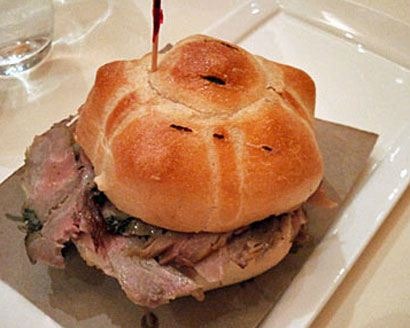Sandwich Of The Week: Porchetta At SD26
Porchetta is arguably the most seductive of Italian street foods. At neighborhood fairs and marketplaces and sometimes just parked alongside the road in various parts of Italy — and especially around Rome and the surrounding Lazio countryside — you'll smell the irresistible aroma of roasting pork fat drifting through the air and, if you follow it, will come upon a cart or van in which a large, barrel-shaped hunk of golden-brown boneless pig rotates on a spit, dripping juices as it darkens. As each customer steps up, shards of moist meat are carved off and layered in a sandwich roll, or panino. It is almost inevitably indecently good.
Tradition has it that porchetta was invented about 15 miles southeast of Rome in Ariccia, one of the so-called Castelli Romani, in the Alban Hills. Roman porchetta is typically stuffed with garlic, fennel seeds, and other herbs. In some other regions, finely chopped pork offal (liver, kidney, intestines, etc.) is often added. In Manhattan, where it is considerably less common than it is in Italy, the simpler stuffing is preferred, and it is rare if not impossible to come upon porchetta on the street.
One of the few New York City restaurants that makes it is SD26 on the north side of Madison Square Park. SD26, run by venerable Italian restaurateur Tony May and his daughter Marisa, is an upscale place with food that is sometimes pretty sophisticated, and it is not the kind of place you'd expect to find this rustic specialty. Nonetheless, porchetta is produced here daily, to be served in the casual front-of-the-restaurant café (though you can probably talk them into bringing it to you in the dining room if you ask nicely). Here, the boneless pork roast is seasoned with fennel seeds, garlic, rosemary, kosher salt, and black peppercorns and roasted over high heat in a convection oven, then rested and sliced.
The meat is very good, even if it lacks that outdoor open-fire character. More to the point, though, is what it's served on. No generic panino here; SD26's porchetta is heaped inside a rosetta. The typical Roman roll, in breadbaskets all over the Eternal City, is the rosetta, shaped like a flower (or rosette), crisp on the outside, and mostly air within. It's not a form of bread found very often in the U.S., and most examples here are just dry and boring. When the Mays decided to serve rosette at SD26, they wanted to do it right. They invited a well-known baker from Rome named Vittorio Corinaldesi, whose three Compagnia del Pane bakeries around the city began as a family business in 1927. Corinaldesi spent three weeks at the restaurant, training its own bakers to properly use the special equipment required to make rosette.
As Tony May explains it, "To produce this type of bread, a particular kind of flour is necessary, as the dough will have to go through a double rise. First it is necessary to have a dough roller, or rollatrice, which the dough is passed through after the first time it has risen. This loosens up the dough, breaking up the fibers. The dough is then allowed to rise again before it is cut into the proper size with another machine called cutter, or spezzatrice. It is then stamped with a hand tool to give it its rose-like shape and finally baked."
Porchetta on a panino is terrific, but porchetta on a rosetta — with meat, sweet fat, and juices soaking into an unusual and addictive roll — is even better; it's the perfect Roman sandwich, and pretty much a perfect sandwich period.
